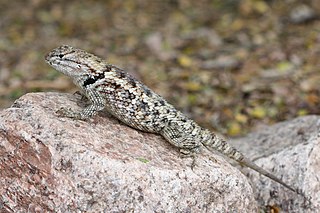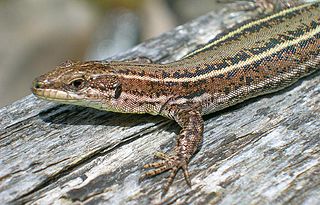
Spiny lizards is a common name for the genus Sceloporus in the family Phrynosomatidae. The genus is endemic to North America, with various species ranging from New York, to Washington, and one occurring as far south as northern Panama. The greatest diversity is found in Mexico. This genus includes some of the most commonly seen lizards in the United States. Other common names for lizards in this genus include fence lizards, scaly lizards, bunchgrass lizards, and swifts.

The western fence lizard is a species of lizard native to Arizona, New Mexico, and California, as well as Idaho, Nevada, Oregon, Utah, Washington, and Northern Mexico. The species is widely found in its native range and is considered common, often being seen in yards, or as the name implies, on fences. As the ventral abdomen of an adult is characteristically blue, it is also known as the blue-belly. Two western fence lizards have been reported with duplicated or forked tails, presumably following an autotomy.

The veiled chameleon is a species of chameleon native to the Arabian Peninsula in Yemen and Saudi Arabia. Other common names include cone-head chameleon, Yemen chameleon, and Yemeni chameleon. They are born pastel green and without their distinctive casques on their head.

Sceloporus magister, also known as the desert spiny lizard, is a lizard species of the family Phrynosomatidae, native to the Chihuahuan Desert and Sonoran Desert of North America.

Urosaurus ornatus, commonly known as the ornate tree lizard, is a species of lizard in the family Phrynosomatidae. The species is native to the southwestern United States and northwestern Mexico. The species, which was formerly called simply the "tree lizard", has been used to study physiological changes during the fight-or-flight response as related to stress and aggressive competition. Its life history and costs of reproduction have been documented in field populations in New Mexico and Arizona. This species has been fairly well studied because of its interesting variation in throat color in males that can correlate with different reproductive strategies,

The eastern fence lizard is a medium-sized species of lizard in the family Phrynosomatidae. The species is found along forest edges, rock piles, and rotting logs or stumps in the eastern United States. It is sometimes referred to as the prairie lizard, fence swift, gray lizard, gravid lizard, northern fence lizard or pine lizard. It is also referred to colloquially as the horn-billed lizard. One of its most notable behaviors is that of its escape behavior when encountering fire ants, which have been known to invade and negatively affect many of their populations.

The granite spiny lizard is a species of lizard in the family Phrynosomatidae.

The sagebrush lizard or sagebrush swift is a common species of phrynosomatid lizard found at mid to high altitudes in the western United States. It belongs to the genus Sceloporus in the Phrynosomatidae family of reptiles. Named after the sagebrush plants near which it is commonly found, the sagebrush lizard has keeled and spiny scales running along its dorsal surface.

Sceloporus malachiticus, the emerald swift or green spiny lizard, is a species of small lizard in the Phrynosomatidae family, native to Central America.

Podarcis hispanicus, also known as Iberian wall lizard, is a small wall lizard species of the genus Podarcis. It is found in the Iberian peninsula, in northwestern Africa and in coastal districts in Languedoc-Roussillon in France. In Spanish, this lizard is commonly called lagartija Ibérica.

Sceloporus variabilis, commonly known as the rose-bellied lizard, is a species of lizard which is found from Central America to southern Texas

Nemipterus virgatus, the golden threadfin bream or yellowlipped threadfin bream, is a species of marine ray-finned fish belonging to the family Nemipteridae, the threadfin breams. This species is found in the Western Pacific Ocean.

Bothrops bilineatus, also known as the two-striped forest-pitviper, parrotsnake, Amazonian palm viper, or green jararaca, is a highly venomous pit viper species found in the Amazon region of South America. Two subspecies are currently recognized, including the nominate subspecies described here. A pale green arboreal species that may reach 1 m (3.3 ft) in length, it is an important cause of snakebite throughout the entire Amazon region.

Sexual selection in scaled reptiles studies how sexual selection manifests in snakes and lizards, which constitute the order Squamata of reptiles. Each of the over three thousand snakes use different tactics in acquiring mates. Ritual combat between males for the females they want to mate with includes topping, a behavior exhibited by most viperids in which one male will twist around the vertically elevated fore body of its opponent and forcing it downward. It is common for neck biting to occur while the snakes are entwined.
Lizards are among the most diverse groups of reptiles, with more than 5,600 species. With such diversity in physical and behavioral traits, lizards have evolved many ways to communicate. Communication may be physical, chemical, tactile, or vocal, and varies according to habitat, sexual selection practices, and predator avoidance methods. Each type of communication uses different sensory systems, including visual, olfactory, and auditory.

Sceloporus uniformis, also known as the yellow-backed spiny lizard, is a reptile of the family Phrynosomatidae. It is native to the Mojave and Great Basin deserts. Until recently, it was considered to be a subspecies of Sceloporus magister.

Aspidoscelis costatus, also known as the western Mexico whiptail, is a species of whiptail lizard endemic to Mexico, including Guerrero, Morelos, and Puebla in southern Mexico, as well as other Mexican states. Its range spans both temperate and tropical habitats, and even densely populated urban areas. Its common name, the Western Mexico Whiptail, can easily be confused with the Western Whiptail, which refers to a different lizard, Aspidoscelis tigris.


















